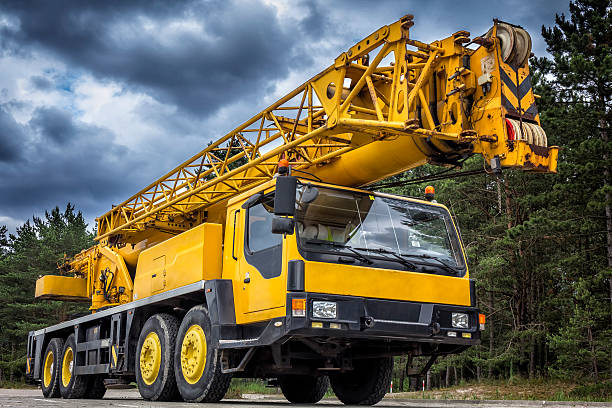In the realm of construction and heavy lifting, mobile crane operation plays a pivotal role in the successful completion of countless projects. Understanding the nuances of load charts is not just a matter of regulatory compliance, but a cornerstone of operating efficiency and safety. These charts serve as essential guides that inform operators about the limitations and capabilities of their cranes, ensuring that each lift is performed within the machine’s operational parameters.
The significance of load charts extends beyond the mere avoidance of mechanical overload; it is integral to the integrity of both the project at hand and the safety of all personnel involved. By meticulously adhering to these detailed diagrams, crane operators can uphold the principles of quality and pride in their workmanship—principles that are the lifeblood of any reputable construction endeavor. In mobile crane operation, an operator’s ability to interpret load charts accurately is synonymous with the mastery of their craft.
What Is a Load Chart?
A load chart is an essential tool in ensuring the safe and effective use of cranes during lifting operations. It provides an overview of the crane’s capabilities and limitations. Delving into the components of a load chart, one can find crucial information such as rated capacities, lifting ranges, and the effects of boom angles and lengths. Understanding these components is vital for planning and executing lifts without compromising safety. Additionally, there are various types of load charts tailored to different crane models and configurations, each vital for its specific application.
Overview of a Load Chart
As we delve into the intricate world of heavy machinery, understanding the backbone of safe and efficient lifting becomes crucial. A load chart is an essential guide that is integral to the process of lifting and handling materials, especially within the realms of construction and heavy industry. It serves as the navigator for crane operators, ensuring that the capacities and limitations of their machinery are respected and adhered to.
The overview of a load chart succinctly maps out the maximum lifting capacities of cranes under various conditions and configurations. This includes data on the boom length, the radius of operation, and the angle of lift, among other critical factors. Essentially, it is the operator’s handbook that dictates the safe boundaries within which the crane can operate without risking overloading or tipping.
Components of a Load Chart
As we delve into the intricate world of crane safety and efficiency, understanding the Components of a Load Chart becomes paramount. At the heart of safe crane usage, the load chart is an essential tool that guides operators in determining the maximum lifting capacity under various conditions. Each chart meticulously outlines key elements such as the rated capacity, which specifies the weight the crane can safely lift at a given radius. The load radius is also marked, indicating the horizontal distance between the center of rotation and the load. Additionally, the chart includes the boom length, where different lengths correspond to different load capacities. Crucial information about counterweights used to balance the crane during operations is provided, ensuring stability and safety.
Types of Load Charts
As we delve deeper into the realm of lifting and rigging, it’s essential to understand the diversity within the tools that govern safety and efficiency. Load charts are no exception, and they come in various types, each tailored to specific equipment and operations. Let’s explore the types of load charts that are critical in the industry:
- Manufacturer Load Charts
- OEM Charts: These are provided by the original equipment manufacturer and are specific to each model of lifting equipment.
- Customized Charts: Sometimes, manufacturers provide charts that are tailored for specific configurations or attachments.
- Crane-Specific Load Charts
- Telescopic Crane Charts: Used for cranes with extendable booms, detailing capacity at various lengths and angles.
Understanding Load Capacity
In assessing load capacity, various factors come into play, such as the crane’s mechanical design, the stability of the ground, and environmental conditions. The ability of a crane to safely lift and transport loads can be significantly influenced by these elements. Following a thorough evaluation, the precise calculation of load capacity becomes crucial. This ensures that operations within the lifting parameters are both efficient and secure. To maintain the highest level of safety, observing essential precautions, like verifying load weight and ensuring proper rigging, is imperative. These steps are fundamental in crane utilization to prevent overloading and potential accidents.
Factors Affecting Load Capacity
Having explored the intricacies of load charts, our attention shifts to the myriad factors that influence load capacity. Paramount among these is the equipment type; different machines have varying capabilities and limitations. In the realm of Mobile crane Operation, the boom length is critical; as it extends, the load capacity may decrease due to increased leverage against the crane. Additionally, counterbalance weight, which ensures stability, must be meticulously calculated to prevent tipping. The lifting radius, which is the horizontal distance from the center of rotation to the load, also has a substantial impact on the capacity. Environmental conditions such as wind speed and ground conditions can dramatically affect operation safety and efficiency.
Calculating Load Capacity
As the gears of knowledge mesh together, we smoothly transition from understanding load charts to the nuts and bolts of calculating load capacity. This vital cog in the machinery of safe lifting practices cannot be overlooked.
Calculating load capacity is a critical task in ensuring the safety and efficiency of crane operations. It involves a thorough understanding of various factors, including the weight of the load, boom length, radius, and the crane’s configuration. The process typically follows these steps:
- Determine the Weight of the Load
- Include the weight of all rigging and lifting devices.
- Account for any additional load attachments.
- Refer to the Load Chart
- Identify the correct chart based on the crane configuration and setup.
Load Capacity Safety Tips
Transitioning from the technicalities of load charts, it’s crucial to acknowledge the gravity of safety in crane usage. Load capacity safety tips are not just recommendations; they are the lifeline that protects workers and equipment in the realm of heavy machinery operation.
When it comes to ensuring safety, it’s imperative to conduct a thorough inspection of the crane before use. This includes checking for any mechanical issues that could affect the load capacity. Always adhere to the manufacturer’s specifications and never attempt to lift a load heavier than the designated capacity. Operators should be trained to understand the importance of the crane’s stability and its load’s center of gravity.
Moreover, environmental conditions such as wind speed and ground stability must be constantly monitored.
Importance of Load Chart Awareness
Understanding load charts is pivotal in ensuring safety and efficiency in crane usage. These charts are fundamental tools in crane operation, guiding operators to determine the maximum load a crane can handle under various conditions. The role of load charts is integral, as they directly influence decision-making during lifts. Adhering to the information provided by these charts not only mitigates the risk of accidents but also optimizes the performance of the crane. Embracing the benefits of load chart awareness can lead to a significant reduction in workplace incidents, promoting a culture of safety and proficiency in lifting operations.
Why Load Charts Are Important
Transitioning from the nuts and bolts of understanding load capacity, we venture into the critical territory of load chart awareness. Why Load Charts are Important cannot be overstated; they are the cornerstone of safe and efficient crane usage. These charts serve as a comprehensive guide for operators, detailing the limitations and capabilities of a crane under various conditions. Without a thorough knowledge of load charts, the potential for miscalculations rises, which can lead to catastrophic accidents, costly damages, and significant downtime. They encapsulate years of engineering expertise, ensuring that every lift is within the safe operating range of the equipment. In essence, load charts are the blueprint for successful and responsible crane use, a crucial aspect of any mobile crane operation.
The Role of Load Charts in Crane Operation
As we shift gears from understanding load capacity, it’s crucial to delve into the navigational chart of crane operation—the load chart. In the realm of crane usage, load charts serve as the quintessential roadmap, guiding operators through the intricate journey of lifts. These charts are not mere suggestions but rather the backbone of crane functionality, dictating the safe limits of weight and the crane’s range of motion. Operators must refer to the load chart to determine the maximum lifting capacity at various boom angles and lengths, ensuring the safety and efficiency of the operation. Adherence to these charts is non-negotiable, as they are the lifeline that connects the theoretical knowledge to the practical execution of complex lifting tasks.
The Benefits of Load Chart Awareness
Gaining a solid understanding of load capacity is akin to mastering the foundations of a language—essential but not entirely sufficient for fluency. Equally vital is the awareness of load charts, the Rosetta Stone of crane operation. Here are the benefits of such awareness:
- Enhanced Safety
- Knowing precise load limits prevents dangerous overloading.
- Awareness of the load’s radius ensures stability during lifts.
- Operational Efficiency
- Correct load chart usage optimizes crane setup time.
- It enables more accurate job planning, reducing downtime.
Understanding load charts is a cornerstone in the safe and efficient handling of lifting equipment.
Conclusion
Understanding load charts is vital for the safe and efficient use of cranes in lifting operations. These charts serve as fundamental guides that ensure operators adhere to the specified load capacity, preventing overloading and potential accidents. It is the responsibility of every professional involved in crane operations to be well-versed in interpreting these charts as they are integral to maintaining workplace safety and operational integrity.
In conclusion, load charts are an essential aspect of crane safety and performance. Mastery of these guides is a non-negotiable component in the realm of mobile crane operation and is critical for the protection of personnel, equipment, and the successful completion of lifting tasks. Proper understanding and application of load charts underscore the importance of precision and care in the realm of heavy lifting and construction.



